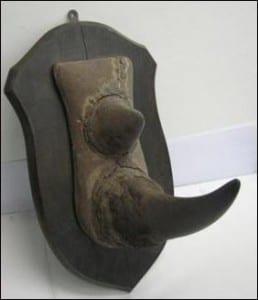Rhinos, armed robbery and arsenic
By Emma-Louise Nicholls, on 23 August 2011
The Animal
 Let’s call a spade a spade. If you look at a rhino I mean *really* look at it, go on don’t be shy there’s one right there, it’s a weird looking beast. Its great big head has tiny little eyes and its massive bulk makes it a formidable animal. The most rhino-y feature is of course the horn. A lot of animals have tusks, antlers, or maybe even horns, but no other species stumbling through evolution on a cold Pliocene day thought “I know, I’ll take this horn of mine and pop it onto my nose, hah haaah, that’ll impress the ladies”. No, they are unique. The rhino is a truly remarkable and remarkable looking animal.
Let’s call a spade a spade. If you look at a rhino I mean *really* look at it, go on don’t be shy there’s one right there, it’s a weird looking beast. Its great big head has tiny little eyes and its massive bulk makes it a formidable animal. The most rhino-y feature is of course the horn. A lot of animals have tusks, antlers, or maybe even horns, but no other species stumbling through evolution on a cold Pliocene day thought “I know, I’ll take this horn of mine and pop it onto my nose, hah haaah, that’ll impress the ladies”. No, they are unique. The rhino is a truly remarkable and remarkable looking animal.
So this horn, what’s it all about? Rhino horn is made of keratin. What’s that you say? Look down at the tips of your fingers (or toes if you’d prefer) and (hopefully) you will be looking at some keratin. Some of you may need to remove nail varnish before you can give your keratin a really good inspection. Yes rhino horn is made of the same stuff as finger nails.
The Issue
 Many of you may suffer from that naughty habit of biting your nails. That’s not so bad overall, if you don’t swallow them. And yet, this is what many cultures in Asia do as a remedy for illnesses. Though I don’t mean their own nails, they eat the nails of rhinos. Or, the rhino’s other source of keratin- the horn, to get to the point (pun intended). Why do they do this? Mighty good question. Traditional Chinese medicine (or TCM) is an age old tradition of ‘remedies’ that in the case of rhino horn are thought to cure maladies such as headaches, pus-filled boils and even devil possession. I wouldn’t want to deny anyone a little headache relief, let alone a little devil expulsion, but there are two tiny issues that should be considered here:
Many of you may suffer from that naughty habit of biting your nails. That’s not so bad overall, if you don’t swallow them. And yet, this is what many cultures in Asia do as a remedy for illnesses. Though I don’t mean their own nails, they eat the nails of rhinos. Or, the rhino’s other source of keratin- the horn, to get to the point (pun intended). Why do they do this? Mighty good question. Traditional Chinese medicine (or TCM) is an age old tradition of ‘remedies’ that in the case of rhino horn are thought to cure maladies such as headaches, pus-filled boils and even devil possession. I wouldn’t want to deny anyone a little headache relief, let alone a little devil expulsion, but there are two tiny issues that should be considered here:
1) Repeated scientific tests have shown that rhino horn has absolutely no medicinal value. It cures diddly squish. In fact, recent results have suggested that rhino horn is even bad for your health.
2) Wild rhino numbers are being decimated to fuel this black market and horns are often taken in the most barbaric of ways. As a result of poaching, three of the five rhino subspecies are critically endangered. The other two are listed as vulnerable and near threatened.
The Museums
 Here comes the part that throws the sad reality of the situation into a mixing pot with a bizarre crime/thriller novel. With rhino numbers drastically decreasing in the wild, black market dealers are turning their attention to rhino horns kept by antique dealers, auction houses and museums. Subsequently, 22 thefts have occurred throughout Europe in the last six months, and on occasion have been accompanied by the use of tear gas and gun wielding. Not exaggerating.
Here comes the part that throws the sad reality of the situation into a mixing pot with a bizarre crime/thriller novel. With rhino numbers drastically decreasing in the wild, black market dealers are turning their attention to rhino horns kept by antique dealers, auction houses and museums. Subsequently, 22 thefts have occurred throughout Europe in the last six months, and on occasion have been accompanied by the use of tear gas and gun wielding. Not exaggerating.
The Twist
Better to steal from a museum than to kill a living rhino of course (though neither are desirable, especially any scenario that involves being held up at gunpoint which I’ve tried and don’t recommend), but unfortunately, up until the early 20th Century, health and safety was really yet to evolve as a department and specimens such as rhino horns were soaked in arsenic and regularly coated in DDT to keep away pests. DDT and arsenic, for those of you who slept your way through chemistry at school, are both very dangerous, poisonous substances that most importantly, maintain their potency over time.
 The Acting Director of Save the Rhino International, Lucy Boddam-Whetham, said recently “Experts agree we are facing the worst rhino poaching crisis in decades”. Now, to add insult to grotesque injury, not only are we facing the loss of a remarkable animal but we are also going to lose our cultural heritage, and specimens that serve as important teaching aids and conservation props that help us spread the word of the rhino’s plight. Yes that does works, I’ve seen it in action. Plus of course, if you’re eating arsenic coated rhino remedies in China, you’ll probably be losing your health as well.
The Acting Director of Save the Rhino International, Lucy Boddam-Whetham, said recently “Experts agree we are facing the worst rhino poaching crisis in decades”. Now, to add insult to grotesque injury, not only are we facing the loss of a remarkable animal but we are also going to lose our cultural heritage, and specimens that serve as important teaching aids and conservation props that help us spread the word of the rhino’s plight. Yes that does works, I’ve seen it in action. Plus of course, if you’re eating arsenic coated rhino remedies in China, you’ll probably be losing your health as well.
The End?
 In a joint statement, Save the Rhino International and company wrote:
In a joint statement, Save the Rhino International and company wrote:
“The trafficking of these species will only end when the demand does – or when the supply runs out – whichever happens first. For the sake of the rhinos, and all of us, we hope that it will not be the latter.”
Couldn’t have said it better myself.
14 Responses to “Rhinos, armed robbery and arsenic”
- 1
-
2
Rachael Sparks wrote on 24 August 2011:

I wonder what the symptoms of diddly squish might be …? Or is that just the sound of an evil rhino horn collector being trampled into the mud by a retributionary herd?
- 5
-
7
UCL Museums & Collections Blog » Blog Archive » Happy World Rhino Day!!!! wrote on 22 September 2011:

[…] A previous blog tells you briefly of the trials and tribulations of being a rhino in the modern day and outlines the myth that is ending the lives of rhino after rhino, so I shan’t repeat it here. Suffice to say, it is a sad, cruel, frustrating story that starts in human ignorance and ends in rhino slaughter. But don’t give up hope my friends! No no, that would be silly. For the populations of white rhino were in a dire state not so long ago and by mega conservation action and a lot of dedicated folk doing their thing by the power of the donated cashflow (did you think I was going to say Grayskull?), the white rhino bounced back! It isn’t out of the woods yet as illegal poaching, as with all five species, is still a huge threat. But, it shows what we can do when we put our heads together people. So, what do you think? Do you want to be responsible for saving a species? Yes? Then go and do it my friend! ‘Save the rhino international‘ and ‘Saving rhinos‘ are two great websites full of information that will get you pointed down the right rhino track and World Rhino Day is the perfect excuse to get started. […]
-
8
UCL Museums & Collections Blog » Blog Archive » A minute’s silence for the Vietnamese Javan rhino wrote on 25 October 2011:

[…] Rhino horn is used in Traditional Chinese Medicine. However, it is made of keratin, the same material as your finger nails and has been repeatedly scientifically proven to have no medicinal value whatsoever. The rhinos are dying for nothing. […]
- 9
-
11
Horn vs Antler | UCL UCL Museums & Collections Blog wrote on 11 July 2013:

[…] keratin growing from the skin. Unless you have horns, keratin has no medicinal or magical powers. The ill-informed think it cures all manner of ills, but all such beliefs do is drive some of the largest living mammals to extinction, make scumbags […]
-
12
The time to live life is now | UCL UCL Museums & Collections Blog wrote on 7 November 2013:

[…] As climate change and habitat destruction change the face of the planet, it isn’t just the well advertised potential extinctions that are the only consequence. Animal species are moving north or south accordingly, in an attempt to continue living within their preferred temperature ranges. Unusual birds are turning up in the UK, red foxes are now clashing with arctic foxes (and winning), and whale watching trips have had dramatic falls in sightings of whales and dolphins in northern Europe as changes in water temperature lead them elsewhere. It isn’t just climate change and habitat destruction of course, there are other factors contributing to the rapid decline in species’ populations such as hunting for meat, fur and the pet trade, plus the infuriating situation of animal parts acquired for ‘medicine’. […]
-
13
Do Dodo Bones Belong in a Museum? | UCL UCL Museums & Collections Blog wrote on 14 November 2013:

[…] Puts them at Risk If the museum governors get tempted, so might criminals. Certain museum objects – particularly rhino horn – have been targeted by organised criminals, often in violent attacks. The sector has […]
- 14
 Close
Close


I suppose there is a bright side – maybe a few dozen well publicised poisoning cases as a result of snorting rhino horn will help curb the demand!